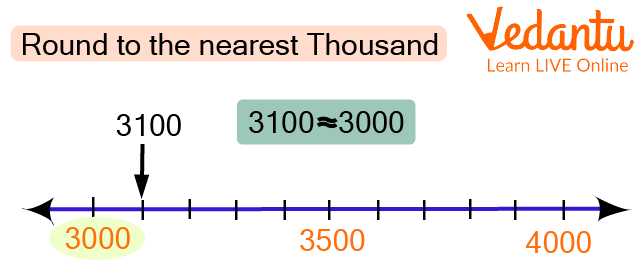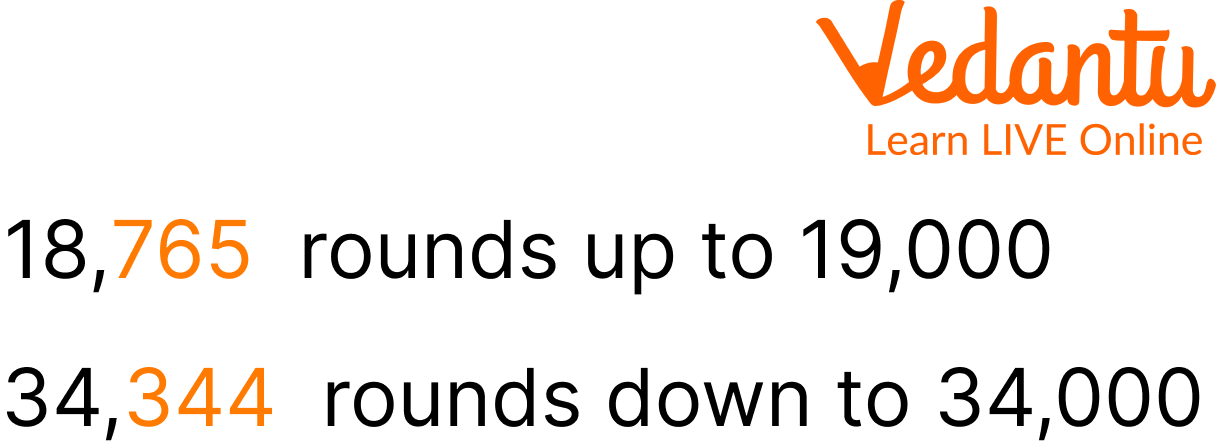




How to Round Numbers to the Nearest 1000: Rules and Practice
Rounding off numbers is an interesting concept. It rounds off a number to the nearest tens, hundreds, thousands, or so on. This concept is used in our daily life. For example, there are 495 students in a school, so we round off the number and say that there are around 500 students in the school. Let us understand the full concept of what is the nearest thousand and nearest hundred and Rounding off to the Nearest 1000 and 100 with a few rounds to the nearest thousand examples.
Number Line Representation
Let us understand the concept of rounding to the nearest thousand examples through number line representation.

Round to Nearest Thousand
In this example, we can understand that below 3500 numbers would round off to 3000, and above 3500 would round off to 4000. So 3450 would round off to 3000 and 3890 would round off to 4000. This will be followed in all the numbers which need to get rounded off to the nearest thousand.
Rounding Numbers to The Nearest 1000
To round to the nearest thousand examples we write the estimated value which is a simpler representation of the number.

Round to Nearest Thousand
We have to understand the place value of the numbers in rounding off to the nearest concept. To round off to the nearest thousand, we need to write the multiple of 1000 which is closest to that specific number. For example, 1120 students are studying in a university, in this case, we usually say that there are around 1000 students in round figures.
Solved Examples
Q 1. Round 3240 to the Nearest thousand
Ans: To solve this question we have to see whether 3240 is closer to 3000 or 4000 in the counting series. In this case, 3240 is closer to 3000, hence the round-off figure of 3240 is 3000.
Q 2. Round 7980 to the Nearest thousand
Ans: To solve this question we have to check whether 7980 is closer to 7000 or 8000 in the counting. In this case, 7980 is closer to 8000, hence 8000 is the round figure of 7980.
Q 3. Round 8039 to the Nearest Thousand
Ans: To solve this question we have to check whether 8039 is closer to 8000 or 9000 in the counting. In this case, 8039 is closer to 8000, hence 8000 is the round figure of 8039.
Q 4. Round 16796 to the Nearest Thousand
Ans: To solve this question we have to check whether 16796 is closer to 16000 or 17000 in the counting. In this case, 16796 is closer to 16000, hence 17000 is the round figure of16796.
Practice Questions
Q 1. What is the nearest thousand of 5321?
Ans: 5000 is the round-off number.
Q 2. What is the nearest thousand of 8999?
Ans: 9000 is the nearest thousand.
Q 3. What is the nearest thousand of 6294?
Ans: 6000 is the nearest thousand.
Q 4. What is the nearest thousand 1964?
Ans: 2000 is the nearest thousand.
Q 5. What is the nearest thousand of 9839
Ans: 10000 is the nearest thousand.
Summary
Rounding Numbers to the nearest thousand is a similar concept to rounding numbers to the nearest tens or hundred. We use this concept in our daily lives while counting money or buying things. Whenever we go to the market for shopping, we keep money with us in round figures. Rounding off the numbers to the nearest tens, hundred, and thousand is done by keeping the place value of digits in mind. Kids must learn and understand this topic in greater detail as it helps in various other concepts and real life.
FAQs on Rounding Off to the Nearest 1000 Made Simple
1. What does it mean to round off a number to the nearest 1000?
Rounding off to the nearest 1000 means simplifying a number to the closest multiple of 1000 (like 2000, 3000, 4000, etc.). It is a form of estimation that makes large numbers easier to understand, compare, and use in calculations, even if it makes the number slightly less precise.
2. What is the rule for rounding off numbers to the nearest 1000?
To round off a number to the nearest 1000, you must follow a two-step rule:
- First, look at the digit in the hundreds place.
- If the hundreds digit is 4 or less (0, 1, 2, 3, 4), you round down. This means you keep the thousands digit the same and change the hundreds, tens, and ones digits to zero.
- If the hundreds digit is 5 or more (5, 6, 7, 8, 9), you round up. This means you increase the thousands digit by one and change the hundreds, tens, and ones digits to zero.
3. Can you give an example of rounding down to the nearest 1000?
Certainly. Let's round off the number 27,345 to the nearest 1000. First, we identify the digit in the hundreds place, which is 3. Since 3 is less than 5, we round down. The thousands digit (7) remains unchanged, and the hundreds, tens, and ones digits become zero. Therefore, 27,345 rounded to the nearest 1000 is 27,000.
4. What is 8,761 rounded to the nearest 1000?
To round 8,761 to the nearest 1000, we check the digit in the hundreds place, which is 7. Since 7 is greater than 5, we must round up. This means we increase the thousands digit (8) by one, making it 9. The remaining digits (hundreds, tens, and ones) are replaced with zeros. So, 8,761 rounded to the nearest 1000 is 9,000.
5. Why is rounding off numbers useful in real life?
Rounding is extremely useful for making quick mental calculations and understanding large numbers in everyday situations. For example:
- Budgeting: If items cost ₹4,890 and ₹2,150, you can round them to ₹5,000 and ₹2,000 to quickly estimate a total of about ₹7,000.
- Population: A city with 692,450 people is often described as having a population of 'about 700,000'.
- Distance: If a journey is 3,210 km, you might say it's 'roughly 3,000 km'.
6. How is rounding to the nearest 1000 different from rounding to the nearest 100?
The key difference is the place value you inspect and the resulting level of precision. When rounding to the nearest 1000, you look at the hundreds digit to make your decision, and the result is always a multiple of 1000. When rounding to the nearest 100, you look at the tens digit, and the result is a multiple of 100. For example, rounding 4,567 to the nearest 1000 gives 5,000, but rounding it to the nearest 100 gives 4,600, which is a more precise estimate.
7. What is the most common mistake students make when rounding to the nearest 1000?
The most common mistake is looking at the wrong digit to make the rounding decision. Students sometimes look at the tens digit or even the ones digit instead of the hundreds digit. Another frequent error is correctly deciding to round up or down but then forgetting to change the hundreds, tens, and ones digits to zeros in the final answer.

















